About a week ago, I decided I wanted to try my hand at photographing the eclipse in a couple days. I went online to see what materials I would need.
Of course, you need solar glasses to look directly at the sun. And I also needed a way to protect the camera. I did not want to spend a couple hundred bucks on a solar filter that would fit my lens, so I bought a sheet of solar film and constructed my own filter.
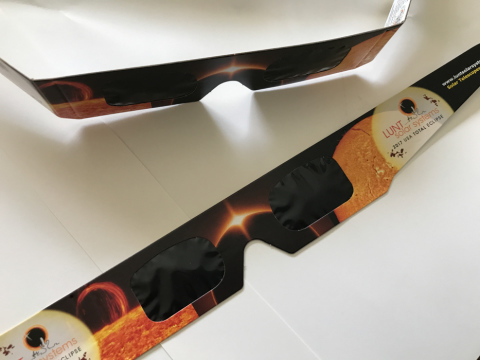
They work well -- the sun turns into a dull yellow ball. You cannot see ANYTHING ELSE -- everything is all black (except for the sun) because the glasses block so much light.
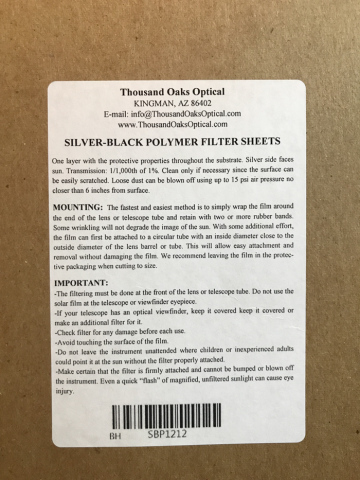
I could have just used the sheet by attaching it to the end of the lens with a rubber band. But there was only 1 sheet, and I needed to do a practice run. So, I decided to cut it and some cardboard and make my own filter.
My first thought was to cut a piece of cardboard to the right size, then tape the film onto it. Here's the cardboard with the hole in it.
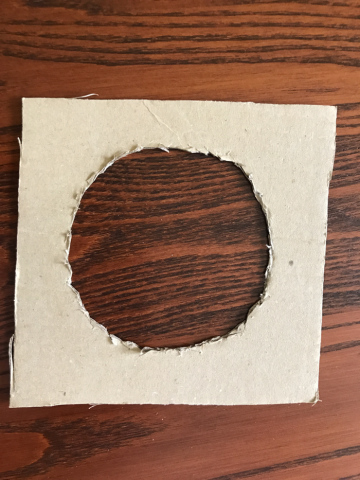
It didn't really work well -- it was too flimsy, and could fall off easily.
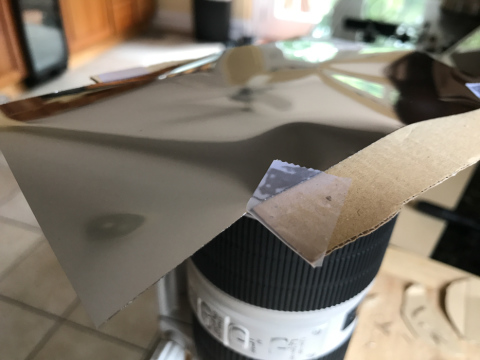
So I got a piece of paper -- one that was less stiff than cardboard, but still a bit stiff. And I cut a strip, which I wrapped around and taped 1 end of the strip to the other to make a kind of tube.
Then I taped the solar film over the end of the tube. I used a rubber-band to hold the tube to the lens.
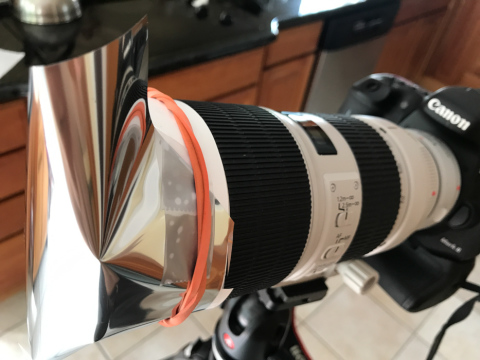
That seemed to work well enough. It felt stable on the lens, and it made it through my practice session.
I may have to change my settings on Monday as the eclipse gets near the 86% mark (which will be our max eclipse here).
Turns out..not long! These 2 images were about 5 minutes apart, which looks like the sun has moved about a 1/4 way across the screen (and down)...meaning, I'll only get 20 minutes of shots before I have to move the lens.

Which begs the question -- what exactly do I want to photograph? I really don't want to spend all my time fooling around with the camera during the eclipse -- I would prefer to watch it with my eyes through my glasses.
But I do want some photos, so I suspect I will aim the camera near the beginning of the eclipse...then move it to take some photos in the middle...and that may be all I take.
Here's the camera set up outside. Note how sharply angled it is! This was a time when I SORELY missed the articulating screen that my Rebel has! With this camera, I had to kneel and look upwards to see the screen!
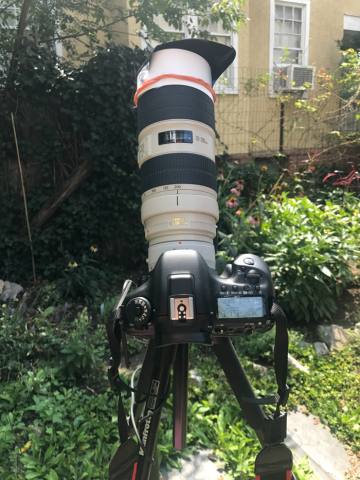
Unfortunately, the weather forecast looks like we may have clouds on Monday so I may or may not get any eclipse photos. But just doing this practice session, and learning about solar film and camera settings for an eclipse has been fun!

Of course, you need solar glasses to look directly at the sun. And I also needed a way to protect the camera. I did not want to spend a couple hundred bucks on a solar filter that would fit my lens, so I bought a sheet of solar film and constructed my own filter.
Solar Glasses
Here are a couple pair of solar glasses --
They work well -- the sun turns into a dull yellow ball. You cannot see ANYTHING ELSE -- everything is all black (except for the sun) because the glasses block so much light.
Home-made Solar Filter for the Camera
The sheet of solar film arrived sandwiched between 2 pieces of cardboard.
I could have just used the sheet by attaching it to the end of the lens with a rubber band. But there was only 1 sheet, and I needed to do a practice run. So, I decided to cut it and some cardboard and make my own filter.
My first thought was to cut a piece of cardboard to the right size, then tape the film onto it. Here's the cardboard with the hole in it.

It didn't really work well -- it was too flimsy, and could fall off easily.

So I got a piece of paper -- one that was less stiff than cardboard, but still a bit stiff. And I cut a strip, which I wrapped around and taped 1 end of the strip to the other to make a kind of tube.
Then I taped the solar film over the end of the tube. I used a rubber-band to hold the tube to the lens.

That seemed to work well enough. It felt stable on the lens, and it made it through my practice session.
Camera Settings
First off, I decided on my camera settings:| ISO: | 100 |
| f/stop: | f/8.0 |
| Shutter: | 1/500 (Later edit -- this was NOT long enough -- too fast! Thankfully, I bracketed. The ones that worked the best were around 1/250 -- so if I did it again, I might try something around that, and bracket.) |
| Focus: | Manual and set to infinity |
| Bracketing: | I bracketed up and down 2 stops, but having looked at the results, I think I will only go 1.5 stops during the eclipse. |
| White Balance: | I set this to what the camera calls "Sunlight", which is 5200K I believe. |
| Intervals: | I used the intervalometer to open the shutter every 10 seconds. Because I was bracketing and using continuous mode, the camera took 3 shots every 10 seconds (1 normal, 1 under-exposed and 1 over-exposed). To get that to happen, I set the LONG to 1, the INTVL to 10, and the N to 0. |
| Lens and Zoom | 200mm lens with a 1.4 extender on a crop sensor camera...so what does that give me....200mm * 1.4 (extender) * 1.6 (crop factor), or about 448 effectively? I'm not sure if that is correct...it's my guess at how it works. |
| Other Settings: | I turned image stabilization off on the lens -- why have it on and lose f/stops when the camera is going to sit on the tripod? |
I may have to change my settings on Monday as the eclipse gets near the 86% mark (which will be our max eclipse here).
Practice Session
One of the goals of the session was to determine how much time the sun would be in view of my lens -- with the lens zoomed in, how long would the sun stay in front of the camera?Turns out..not long! These 2 images were about 5 minutes apart, which looks like the sun has moved about a 1/4 way across the screen (and down)...meaning, I'll only get 20 minutes of shots before I have to move the lens.

Which begs the question -- what exactly do I want to photograph? I really don't want to spend all my time fooling around with the camera during the eclipse -- I would prefer to watch it with my eyes through my glasses.
But I do want some photos, so I suspect I will aim the camera near the beginning of the eclipse...then move it to take some photos in the middle...and that may be all I take.
Here's the camera set up outside. Note how sharply angled it is! This was a time when I SORELY missed the articulating screen that my Rebel has! With this camera, I had to kneel and look upwards to see the screen!

After the Practice Thoughts
One of the nice things for me about photography is that there is always something else to learn to do.Unfortunately, the weather forecast looks like we may have clouds on Monday so I may or may not get any eclipse photos. But just doing this practice session, and learning about solar film and camera settings for an eclipse has been fun!
